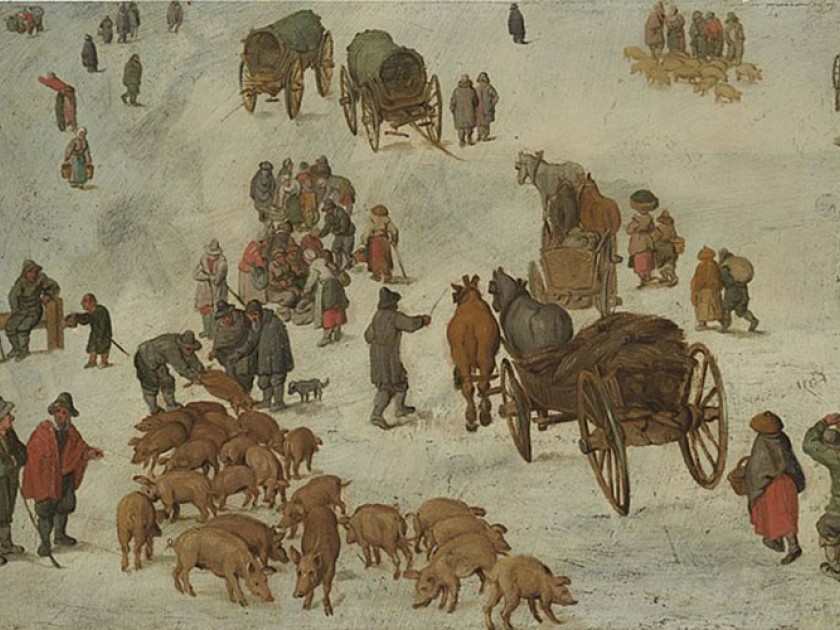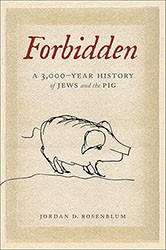
Attributed to Jan Brueghel the Younger, public domain, via Wikimedia Commons
I’ve spent the past twenty years of my career foraging through Jewish history alongside a trusty — and very treyf—companion: the pig. No matter where I turned throughout Jewish history, I found the pig. In fact, even when I was off the clock (does such a concept apply to an academic?), I found the pig. Watching TV, I would catch a Jewish pig joke. Reading a biography of Geddy Lee, the singer and bass player for the band Rush, I encountered a scene in which his Holocaust-surviving father eats bacon and eggs. The pig stalked me like I was a truffle. Finally, I relented and wrote Forbidden: A 3,000-Year History of Jews and the Pig. I collected all of my pig facts and told the story of Jews and the pig, from proverbial snout to tail.
What are my pig facts, you inquire? Well, I’m delighted you asked. (Of course, if this were a party, my family would roll their eyes and try to subtly tell me — perhaps by kicking me under the table — to shut up about the pig already and stop embarrassing them.) So without further ado, here are some interesting pig facts from the last three thousand years or so:
The pig isn’t the most non-kosher animal in the Bible. Of course, the pig isn’t kosher, but the Hebrew Bible equally bans the pig, the camel, the hare, and other animals. It isn’t until centuries later that the pig begins to stand out as especially not kosher.
While today people more often remember the miracle of the oil during Hanukkah, in the most ancient narratives about the Jewish holiday, we learn far more about the pig than about olive oil. The Books of the Maccabees (originally written between the second century BCE and the second century CE) narrate at length the story of an old man named Eleazar and a woman and her seven sons who chose to suffer gruesome martyrdom rather than eating pig. This pious act is seen as testifying to their commitment to Judaism and their rejection of foreign domination — and the pig is the central symbol of both. While today Jews celebrate by eating latkes and jelly donuts, in antiquity, they celebrated by not eating pig.
In the medieval period, Jews had to stand on a pig to testify in court. Known as the Jewish Oath, Jews were required to stand on a sow’s skin and put their hand on a Bible in order to testify in court.
During the Spanish Inquisition, Jews who had converted to Catholicism were often called Marranos—meaning “Pigs.” This was because they were suspected of practicing Judaism in secret: “pigs” refers to their perceived hypocrisy (they are as kosher as a pig) and duplicity. Further, many Marranos were killed by the Inquisition because they were accused of not eating pig.
Karl Marx loved a pork-and-matzah sandwich. Every Easter, a young Karl Marx — whose parents had converted from Judaism to Lutheranism — would make himself a sandwich that featured thin slices of Paschal pork and Passover matzah for bread. Did this foreshadow his revolutionary future, or was it just a tasty meal?
In the first half of the twentieth century, Russian Jews demonstrated their commitment to the Communist cause by organizing agricultural collectives centered on pig-breeding. After all, what better way was there for a bunch of communist Jews to demonstrate their rejection of religion than to raise pigs? In the words of a Soviet poster from 1931, spoken in Yiddish, “The pig is our main machine for production of meat in the coming years!”
The pig that appears on my book’s cover was doodled by Jewish American writer Isaac Bashevis Singer. The Nobel laureate would often sign his name by drawing a picture of a pig; in fact, the cover uses the first-known image of his pig signature (pignature?). In doodling a pig to sign his name, Singer was playfully marking himself as a transgressive Jew, but a Jew nonetheless. It should also be noted that Singer was well known for his vegetarianism, so he didn’t eat pigs, he only drew them.
Mama Cass didn’t choke to death on a ham sandwich. Born Ellen Naomi Cohen in Baltimore, Mama Cass rose to fame as a member of The Mamas and the Papas, known for hits such as “California Dreamin’” and “Monday, Monday.” Her tragic death on July 29, 1974 at the age of thirty-two was falsely attributed to her choking on a ham sandwich (when, in fact, it was due to a heart attack). If the person choking to death on a ham sandwich were thin and Protestant, the joke just wouldn’t work. But Cass’s doubly othered body (Jewish and obese) was viewed by far too many as both funnier and more socially acceptable to laugh at. RIP, Mama Cass.
Even today, Jews often tell their stories by means of the pig. Listen to the stories of Jews with a diverse array of experiences and you’ll find that the pig often sticks its snout in when they describe their relationship with Judaism. For example, Abby Chava Stein was assigned male — and Hasidic — at birth. She came out as transgender and, as part of her story of leaving Hasidism, ate bacon. And, of course, there is the famous scene in the movie Annie Hall in which Alvy has dinner in Chippewa Fall, Wisconsin with Annie’s family and ham is served.
Though I can no longer add stories to my book, I continue to find tales of the pig as my research takes me in new directions. I’ve asked the pig to exit stage right, but it continues to hog the spotlight.
Jordan D. Rosenblum is the Belzer Professor of Classical Judaism and Director of the Mosse/Weinstein Center for Jewish Studies at the University of Wisconsin – Madison. He is the author and coeditor of several books including Rabbinic Drinking: What Beverages Teach Us About Rabbinic Literature.



